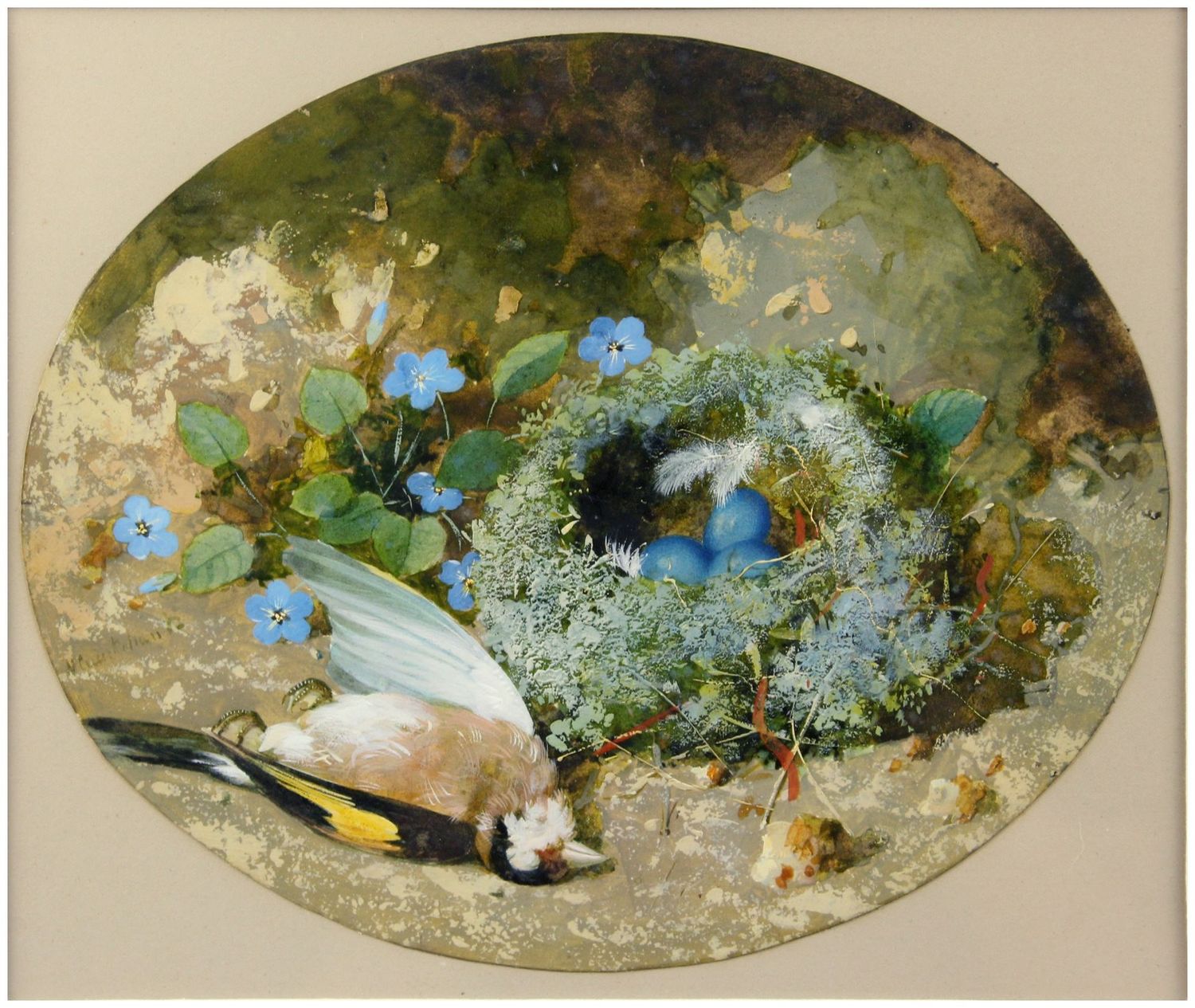Cruickshank, William (19 Jh.), Stilleben mit totem Stieglitz und Nest
William Cruickshank(19 Jh.). Stilleben mit totem Stieglitz und Nest. Aquarell und Gouache auf chamoisfarbenem Papier, 21 x 24,5 cm (Sichtmaß), 40 x 42 cm (Rahmen), linksseitig signiert „W Cruickshank“. Hinter Glas im Passpartout gerahmt.
- Das mystische Blau transzendiert den Tod -
Das Bild verströmt die Atmosphäre einer melancholischen Schönheit. Das Gelege mit den an das wunderbar geheimnisvolle Blau der Romantik gemahnenden Eiern, die dazu passenden blauen Blumen und der Stieglitz mit seinem schwarz-gelb-rotem Gefieder zeigen die Natur in ihrer ganzen Schönheit und doch ist der Stieglitz tot. Er liegt auf dem Rücken, der Kopf ist in unnatürlicher Weise nach hinten geknickt, die Krallen sind leblos in sich zusammengesunken und der eine Flügel in letzter Anstrengung weit aufgefächert. Dadurch wird die Szenerie zu einer natura morta
, zu einem Stilleben, das die melancholische Stille eines ewigen Augenblicks verbreitet. Und doch wohnt dem Bild auch eine Bewegung inne, die durch den schlierenartigen Farbauftrag befördert wird.
Eine Bewegung, die hier das Ineinandergreifen von Leben und Tod bedeutet: Der Tod, den der Stieglitz mitten im Leben ereilt hat noch bevor er den Nachwuchs ausbrüten konnte, während die nicht ausgebrüteten geheimnisvoll blauen Eier zugleich auf ein höheren Leben nach dem Tode verweisen. Schließlich steht der sich von den dornigen Disteln ernährende Stieglitz traditionell für Christus und dessen erlösenden Opfertod ein. In einer vergleichbaren, von der unmittelbaren Veranschaulichung Christi losgelösten Szenerie findet sich der Stieglitz auf dem berühmten, im Mauritshuis in Den Haag aufbewahrten Bild Der Distelfink
(1654) von Carel Fabritius. Dort lebt der Vogel zwar, ist aber angekettet und wird so am Fliegen gehindert.
In dieser Traditionslinie stehend ist das Bild Cruickshanks ein auch den heutigen Betrachter unmittelbar ansprechendes memoto mori
- ein Meditationsbild über Leben und Tod, das zugleich eine Bejahung des Lebens in der ganzen Schönheit der Schöpfung beinhaltet. Um die Lesbarkeit dieses Bildsinns zu verstärken, sind die dargestellten Gegenstände in die Fläche gekippt, so dass sich die einzelnen Bildelemente leichter aufeinander beziehen lassen, ohne dass dadurch der räumliche Eindruck jedoch aufgehoben werden würde.
Cruickshank, der sich auf derartige Bilder spezialisiert hat, verbindet die Emblematik des Barock mit der Bildsprache der Romantik und einem der Landschaftsmalerei entlehnten Duktus. Hierin zeigt sich die meisterhafte Materialbeherrschung Cruickshanks, der die Technik des Aquarells mit der Gouache so verschmilzt, dass sich das Motiv aus einem unbestimmten, in sich bewegten Farbraum heraus durch die intensiveren Farben der Gouache konkretisiert, wobei die ausgeführten Bildgegenstände die ästhetische Qualität der Feinmalerei aufweisen, obwohl diese - wie beispielsweise das Nest - durch eine virtuose Fleckenstruktur gebildet werden.
Auswahlbibliographie
Algernon Graves: The Royal Academy of Arts. A complete dictionary of contributors and their work from its foundation in 1769 to 1904, vol. 2: Carroll to Dyer, London 1905.
Leo R. Schidlof: The miniature in Europe. In the 16th, 17th, 18th, and 19th centuries, vol. 1: A - L, Graz 1964.
Jeremy Maas: Victorian painters, London 1996.
Daphne Foskett: A Dictionary of British miniature painters, London 1972.
Jane Johnson: Works exhibited at the Royal Society of British Artists, 1824 - 1893. An Antique Collectors' Club research project, vol. 1: A - P, Woodbridge 1975.
Adrian Vincent: A companion to Victorian and Edwardian artists, Newton 1991.
Auswahl an öffentlichen Sammlungen Werke von William Cruickshank besitzen
Brighton Museum and Art Gallery, Harris Museum and Art Gallery Preston.

